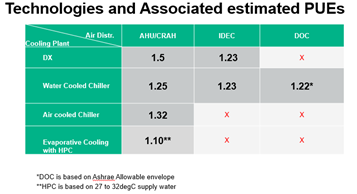With data centre capacity reaching nearly 400MW, Singapore has long been the data centre hub of Asia Pacific. Demand for compute power will remain high due to the growth of e-commerce, artificial intelligence, hybrid-work working, and other industry digitization initiatives. As a result, the data centre segment in Singapore was recently revived after a moratorium on new data centres was lifted, with authorities welcoming applications to build new facilities but with specific requirements on environmental sustainability.
Data centres are intensive users of resources such as electricity and water, and considering Singapore’s resource constraints, as well as the country’s commitment to fulfilling its obligations under the 2015 Paris Agreement, the development of data centres in Singapore must not only meet the growing needs of Singapore’s digital economy but also be sustainable.
These twin goals can be met by developing best-in-class data centres in terms of sustainability – particularly in the areas of resource efficiency and decarbonisation – while contributing towards Singapore’s economic and strategic objectives.
As we embark on the journey for more sustainable data centres in Singapore, several considerations are at play.
The Path Towards Sustainability – Minimising Water Usage for Cooling
The two largest energy consumption sources for data centres are computer servers and cooling systems. Given the warm weather in Singapore, cooling data centres is a significant challenge and a particularly energy-intensive undertaking compared to data centre hubs elsewhere.
Cooling of data centres in high-temperature areas can sometimes involve high water consumption. Water security is a challenge that not only a resource-scarce country like Singapore faces but is a global issue given the effects of climate change. Changes in climate patterns can have a significant impact on the availability and quality of water resources leading to significant variability.
With the climate emergency the world is in, data centres need to optimise water consumption across their cooling systems and reduce wastage. Alternative methods include using air economisers or direct air and or non-evaporative heat rejection to cool data centre facilities. As highlighted in my previous article, the high air quality in Singapore suggests that direct air cooling is a viable option to explore.
The table below illustrates some of the potential PUEs we can achieve with the various cooling methodologies and architectures. The picture below illustrates an innovative cooling configuration in Singapore where PUE below 1.2 can be achieved even at ASHRAE-recommended envelopes. Many solutions or cooling architectures can significantly reduce energy consumption and PUE from the current norms.

IDEC – Indirect Evaporative Cooling
DOC – Direct Outdoor Cooling
HPC – High Performance Computing
Reducing Energy Consumption
Most data centres get their electricity from the local power grid. However, this puts pressure on electricity capacity within cities, and authorities worldwide are placing more scrutiny on data centre power consumption in response to global power shortages and grid constraints.
Data centres can be responsible actors on Singapore’s grid. For example, they can use their energy storage deployments to participate in the Singapore Energy Market Authority’s (EMA) ancillary services market. This could include demand response and peak shaving programs to reduce the grid load during times of high demand. For example, Microsoft and Eaton in Ireland using the UPS systems to feed into the grid when needed.
Of course, reducing energy usage will also reduce the strain on the grid. As per new criteria announced last year, Singapore has mandated that new data centres built have a Power Usage Effectiveness (PUE) of 1.3 or less. Our innovative and industry-leading designs, allow EdgeConneX data centres to attain an average PUE of 1.27 as of 2021. Read more in our 2021 Sustainability Report.
The data centre industry traditionally relied on double conversion UPS units due to perceived reliability advantages. However, power availability and quality in Singapore ranks highest among a global cohort of the world’s leading metropolitan areas[1], allowing the consideration of line interactive UPS solutions.
Operating efficiency for Line Interactive UPS is 98%, as compared to 94% for traditional double-conversion UPS solutions. This translates to a correspondingly lower input power requirement that is 4% lower (or an additional 4% in deployable IT load).
On-site renewables such as solar panels are unlikely to significantly reduce the energy consumption of data centres due to their high energy demands, location and climate constraints, physical limitations, and cost. A comprehensive approach, including energy-efficient design and a mix of alternative renewable energy sources, is needed to meet data centres’ energy demands.
Alternative Sources of Energy
Other than traditional sources of energy, the use of renewables is being explored within the industry to lower the industry’s carbon footprint. For example, Singapore has taken proactive steps to ensure its buildings are greener by installing solar panels.
With limited access to wind, solar or geothermal energy, data centres in Singapore must find other innovative ways to reduce their carbon footprint while also putting less pressure on the local grid. Currently, in Singapore, industry players are exploring alternative means like developing liquefied hydrogen infrastructure to power data centres.
Other options explored in Singapore include developing large-scale solar energy and storage plants in the neighbouring Riau Islands of Indonesia to supply power to the islands and Singapore. Singapore intends to import 30% of its energy via clean power from the region by 2035.
Strengthening Singapore as a Critical Hub
Singapore continues to be the data centre hub of Asia Pacific, with approximately 60% of the region’s data centres located in the country. There is a viable ecosystem here for data centres thanks to high-speed connectivity, widespread adoption of digital technologies, and low risk of natural disasters.
As the demand for data centres continues to grow, Singapore also needs to ensure that high-level talent and critical knowledge to support the development of greener data centres continue to be developed.
Extensive training and proficiency programmes for new and existing employees will tap into a company’s global know-how. It is also common for employees to do rotations across all markets to facilitate knowledge transfer across teams worldwide.
Singapore is a winning example where boundaries are continually pushed to ensure greater sustainability in data centres. As a company that has been innovating and delivering greener data centres around the world, we are excited to partner with the various stakeholders in supporting the expansion of Singapore’s digital economy.
